PDF chapter test TRY NOW
What happens when a fresh fruit, vegetable or cooked food is kept at room temperature for 3 or 4 days?
The colour, texture, and odour changes. Thus, it becomes unfit for human consumption. These are mainly caused due to microorganisms or other internal and external factors seen in the previous theory.
Microorganisms are the main reason which causes food spoilage. Microorganisms are present in the air around us, dust, soil etc. They are present everywhere, and the presence of microbes in or on food is unavoidable. For keeping the food in good condition, the growth of microbes must be prevented.
Food preservation is the process of prevention of food from spoilage or decay by storing it in a condition fit for future use.
Need for food preservation:
1. To increase the shelf life of food
2. To retain the colour, texture, flavour and nutritive value
3. To increase food supply
4. To decrease the wastage of food
5. To make the seasonal food available throughout the year
6. To save food for future use and to stabilize the price of food throughout the year.
Food preservation methods:
There are various methods of food preservation. Some of them are explained below.
A) Drying:
Drying is the process of preservation of food where there is removal of water/moisture content present in the food. Drying inhibits the growth of microorganisms such as bacteria, yeasts and moulds. Drying can be done by:
1. Sun drying:
In countries like India, the sunlight or the rays of the sun are used for drying foods. 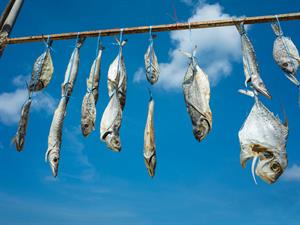
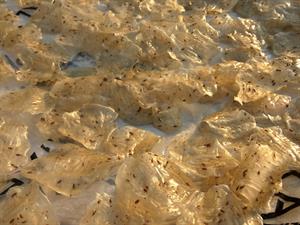
Cereals, fish, shrimp, vegetables like lady's finger, peas, garlic, onion are preserved by sun drying.

Fish drying in the sun
Papad is a snack that is made from cereals and pulses, which is also sun-dried.

Drying papad in sun
2. Vacuum drying:
Vacuum drying is a method that takes place in the absence of oxygen and using mild temperatures. This method thus preserves the nutritive and sensory characteristics of food.
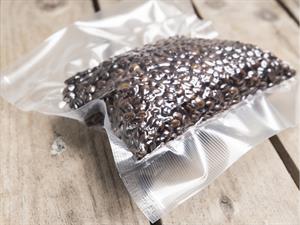
Vacuum dried food
Example:
Milk powder, cheese powder, fruits and vegetables are preserved using vacuum drying methods.
3. Hot air drying:
Food to be dried is placed in contact with a moving stream of hot air. Dryers are used to supply the hot air.
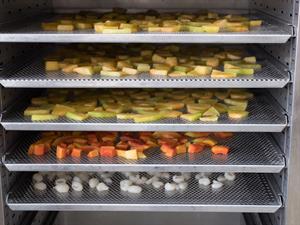
Hot air dryer
Example:
Fruits like grapes (raisins), dry fruits like dried apricots, and potato flakes are preserved by hot air drying.
B) Smoking of food
Food products are dried by exposing them to smoke. The smoke is produced by burning special kinds of wood. The heat from the smoke helps in the removal of moisture, and thus the preservation of food. The exposure of smoke imparts a characteristic flavour to the food.
Example:
Meat and fish are foods that are preserved by the method.
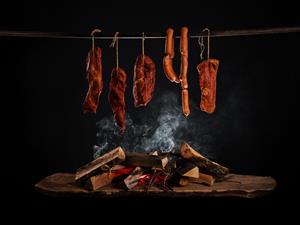
Smoking meat and sausages
C) Food irradiation
It is the process where food is exposed to ionizing radiations (optimum levels) like x-rays, gamma rays or UV rays. The method improves the safety and extends the shelf life of food. Irradiation kills bacteria, pests and preserves and retains the freshness of the produce.
Example:
In potatoes and onions, irradiation prevents or delays the process of sprouting.
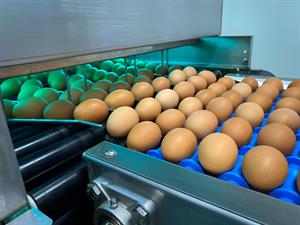
Irradiation of eggs
D) Use of Inert gas
Inert gases like nitrogen is used for packing foods like fresh-cut vegetables (cabbage and lettuce), and other processed foods like chips - potato wafers. The nitrogen gas is filled in the air tight packet, which prevents the growth of fungus and mould in it. Thus, it extends the shelf life of the foods packed in it.
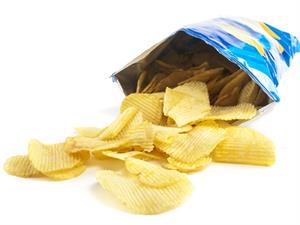
Use of Nitrogen gas in chips
It is also used in roasted coffee, where the shelf life of it is extended. The shelf life is extended by replacing the air present in the package with inert gases like nitrogen. Carbon dioxide can also be used.
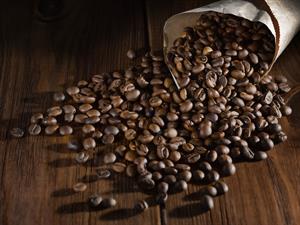
Use of Nitrogen gas or Carbon dioxide gas in Roasted Coffee
